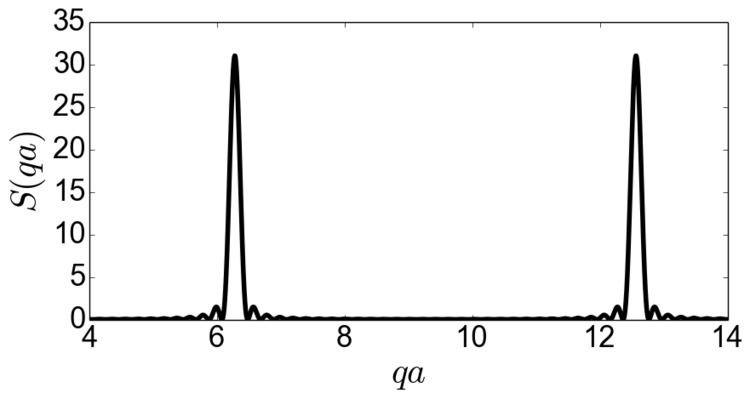 | ||
The Scherrer equation, in X-ray diffraction and crystallography, is a formula that relates the size of sub-micrometre particles, or crystallites, in a solid to the broadening of a peak in a diffraction pattern. It is named after Paul Scherrer. It is used in the determination of size of particles of crystals in the form of powder.
Contents
- Applicability
- Derivation for a simple stack of planes
- Structure factor for a set of N equally spaced planes
- Determination of the profile near the peak and hence the peak width
- Peak broadening due to disorder of the second kind
- Coherence length
- References
The Scherrer equation can be written as:
where:
Applicability
The Scherrer equation is limited to nano-scale particles. It is not applicable to grains larger than about 0.1 to 0.2 μm, which precludes those observed in most metallographic and ceramographic microstructures.
It is important to realize that the Scherrer formula provides a lower bound on the particle size. The reason for this is that a variety of factors can contribute to the width of a diffraction peak besides instrumental effects and crystallite size; the most important of these are usually inhomogeneous strain and crystal lattice imperfections. The following sources of peak broadening are listed in reference: dislocations, stacking faults, twinning, microstresses, grain boundaries, sub-boundaries, coherency strain, chemical heterogeneities, and crystallite smallness. (Some of those and other imperfections may also result in peak shift, peak asymmetry, anisotropic peak broadening, or affect peak shape.)
If all of these other contributions to the peak width were zero, then the peak width would be determined solely by the crystallite size and the Scherrer formula would apply. If the other contributions to the width are non-zero, then the crystallite size can be larger than that predicted by the Scherrer formula, with the "extra" peak width coming from the other factors. The concept of crystallinity can be used to collectively describe the effect of crystal size and imperfections on peak broadening.
Derivation for a simple stack of planes
To see where the Scherrer equation comes from, it is useful to consider the simplest possible example:a set of N planes spaced a apart. The derivation for this simple, effectively one-dimensional case, is straightforward. First we will derive the structure factor for this case, and then determine an expression for the peak widths.
Structure factor for a set of N equally spaced planes
This system, effectively a one dimensional perfect crystal, has a structure factor or scattering function S(q)
where for N planes,
the sums are simple geometric series, defining
converting to trigonometric functions
and finally
which gives a set of peaks at
Determination of the profile near the peak, and hence the peak width
From the definition of FWHM, for a peak at
and
as
To convert to an expression for crystal size in terms of the peak width in the scattering angle
which is the Scherrer equation with K = 0.88.
This is all for 1D set of planes. In the experimentally relevant case of 3D, the form of
Peak broadening due to disorder of the second kind
The finite size of a crystal is not the only possible reason for broadened peaks in X-ray diffraction. Fluctuations of atoms about the ideal lattice positions that preserve the long-range order of the lattice only give rise to the Debye-Waller factor, which reduces peak heights but does not broaden them. However, fluctuations that cause the correlations between nearby atoms to decrease as their separation increases, does broaden peaks. This can studied and quantified using the same simple one-dimensional stack of planes as above. The derivation follows that in chapter 9 of Guinier's textbook. This model has been pioneered by and applied to a number of materials bu Hosemann and collaborators over a number of years. They termed this disorder of the second kind, and referred to these imperfect crystalline ordering as paracrystalline ordering. Disorder of the first kind is the source of the Debye-Waller factor.
To derive the model we start with the definition of the structure factor
but now we want to consider, for simplicity an infinite crystal, i.e.,
where
and we also assume that the fluctuations between a plane and its neighbour, and between this neighbour and the next plane, are independent. Then
The sum in
for
This has peaks at maxima
i.e., the height of successive peaks drop off as the order of the peak (and so
which is a Lorentzian or Cauchy function, of FWHM
Thus finite-size and this type of disorder both cause peak broadening, but there are qualitative differences. Finite-size effects broadens all peaks equally, and does not affect peak heights, while this type of disorder both reduces peak heights and broadens peaks by an amount that increases as
Coherence length
Within this model the degree of correlation between a pair of planes decreases as the distance between these planes increases, i.e., a pair of planes 10 planes apart have positions that are more weakly correlated than a pair of planes that are nearest neighbours. The correlation is given by
which is in effect an order-of-magnitude estimate for the size of domains of coherent crystalline lattices. Note that the FWHM of the first peak scales as
